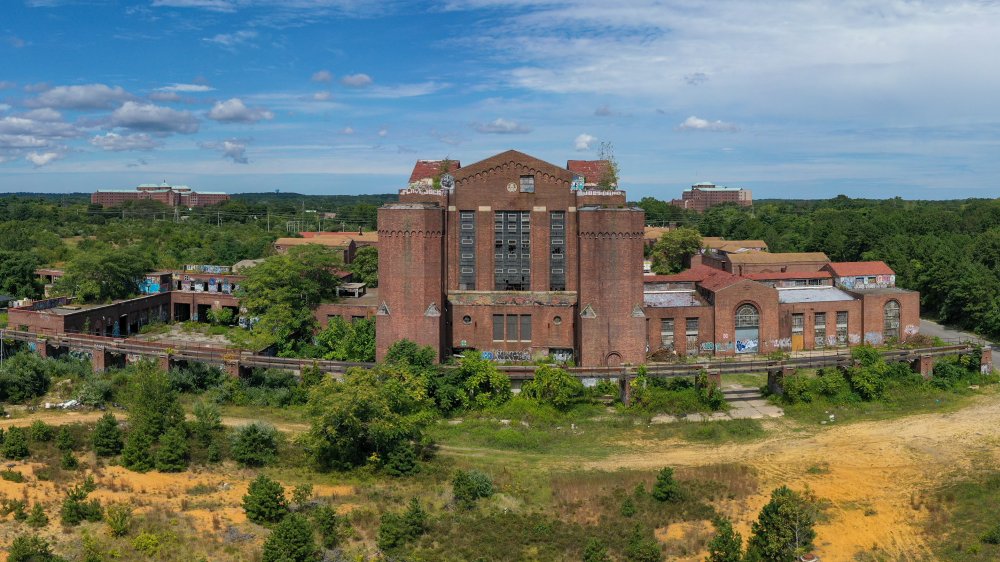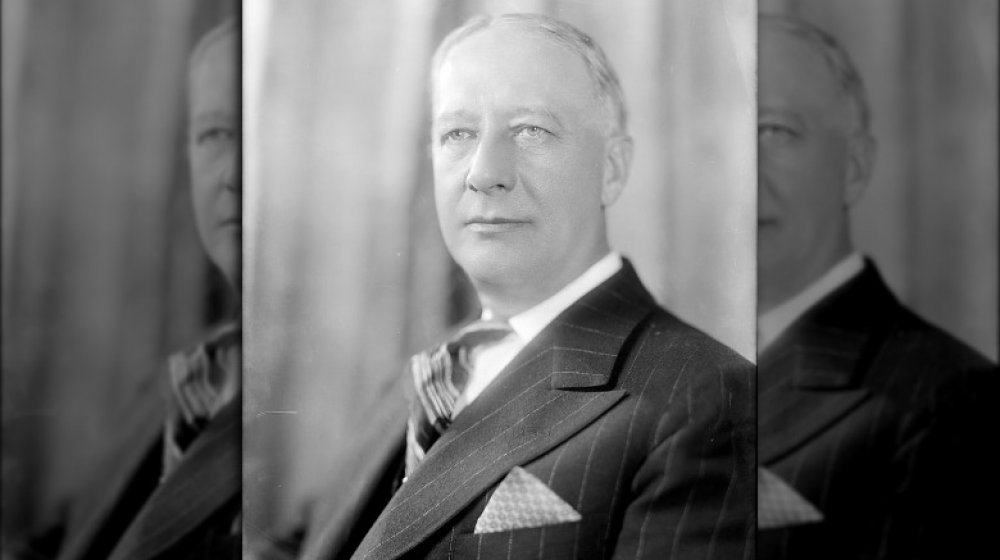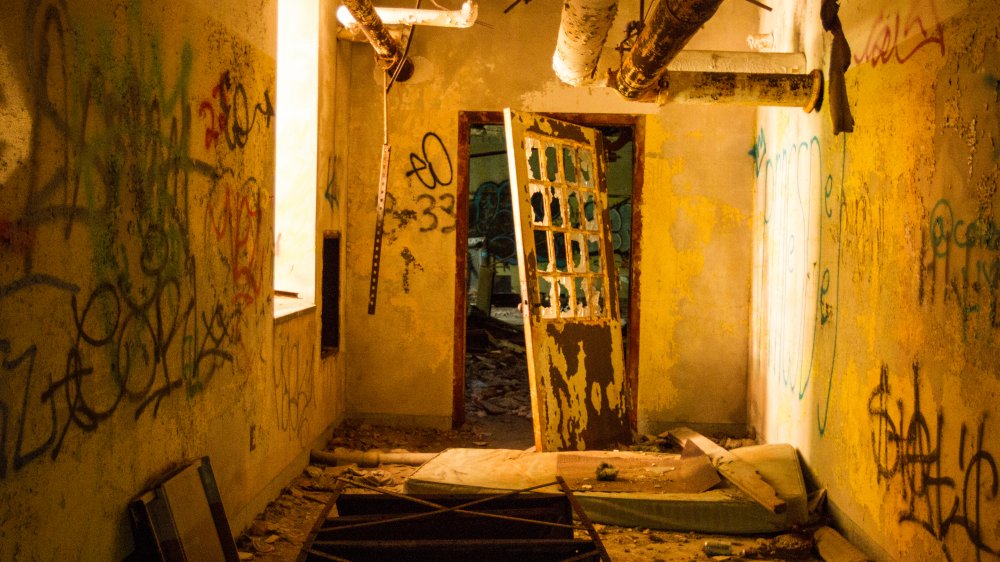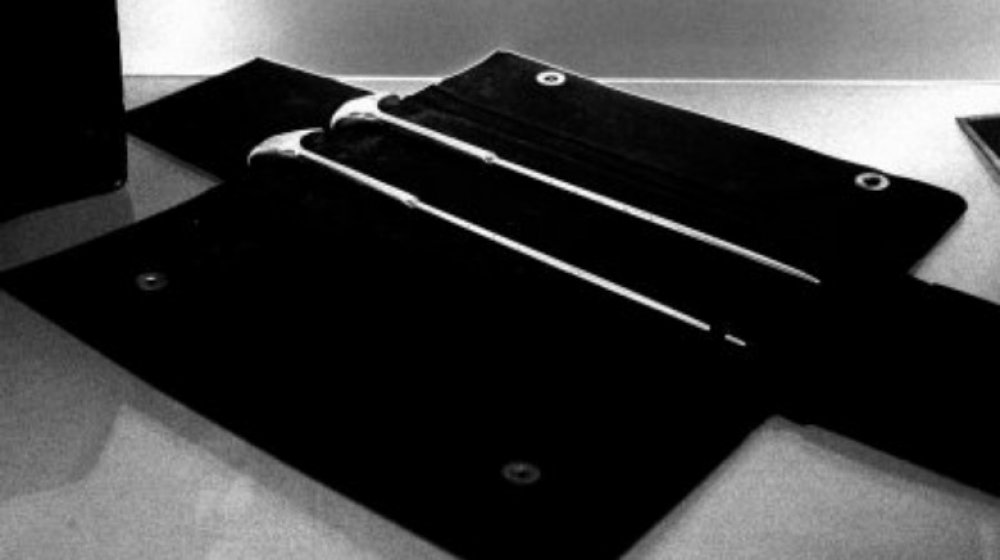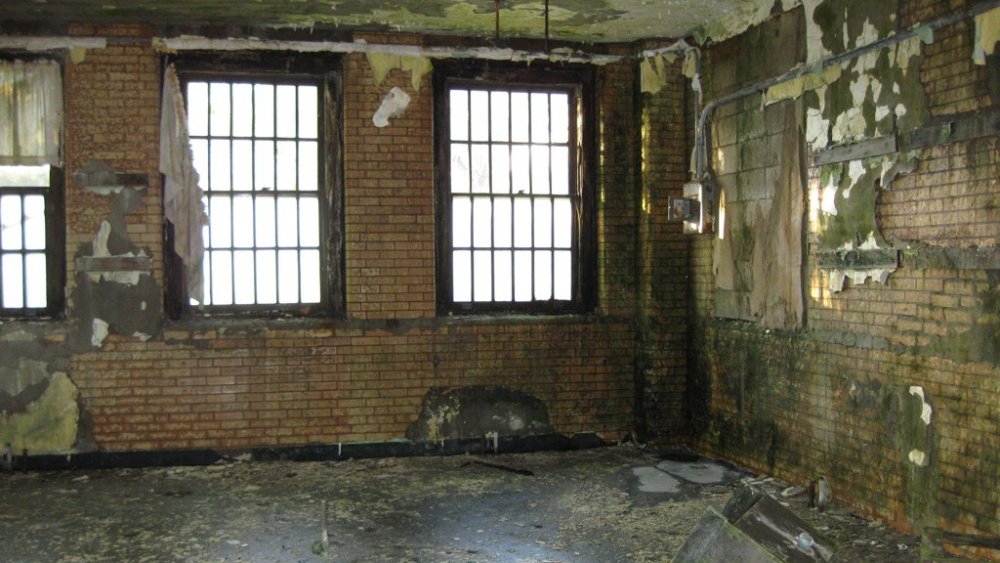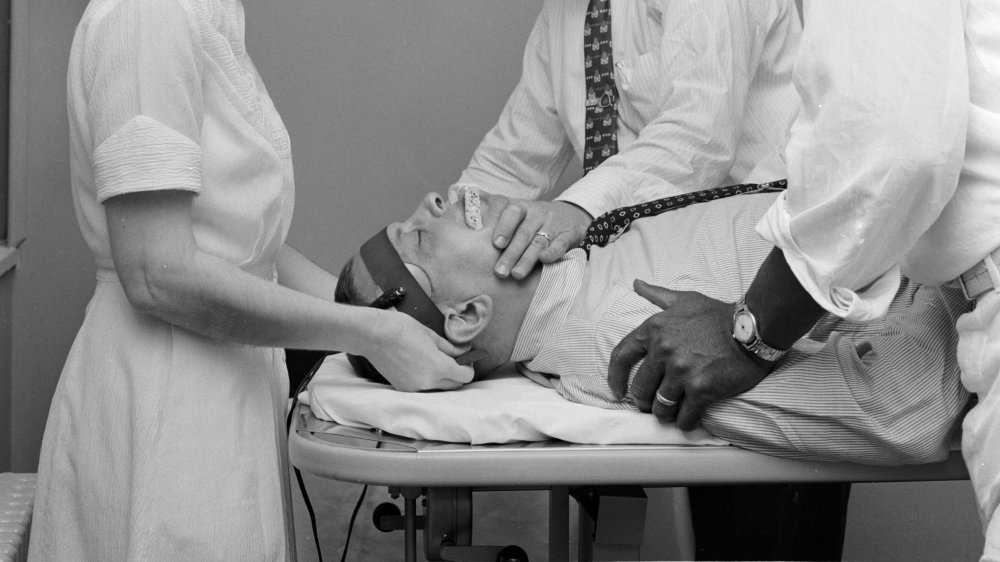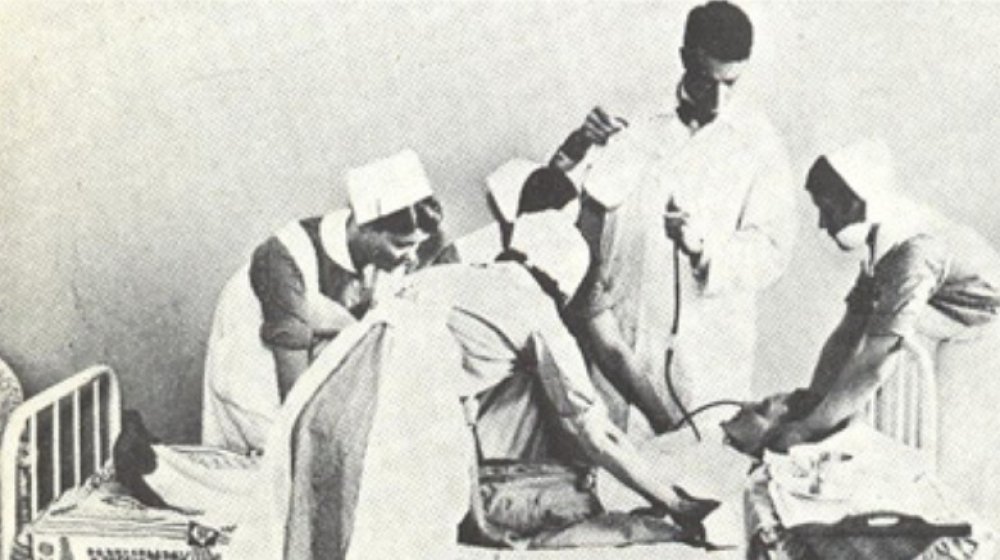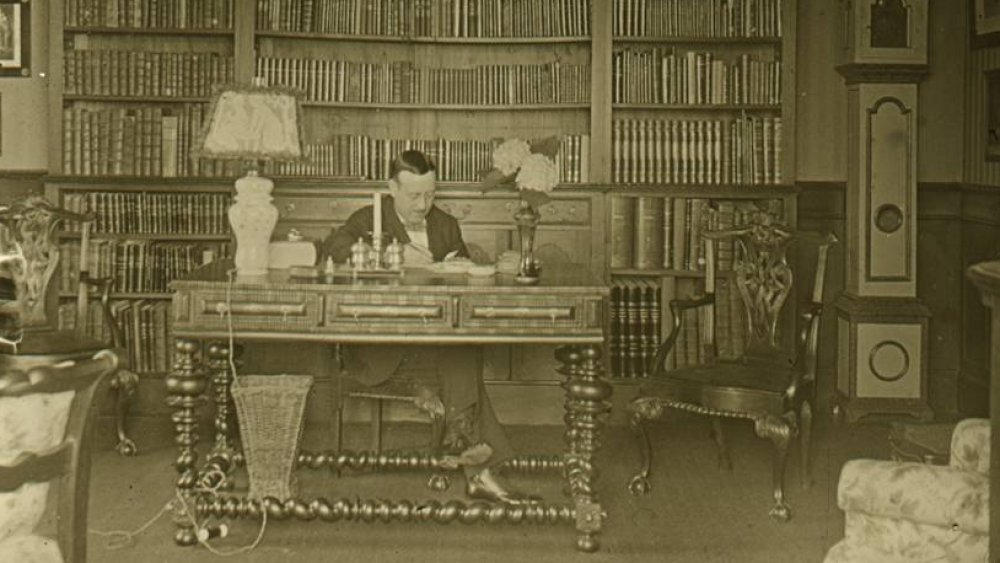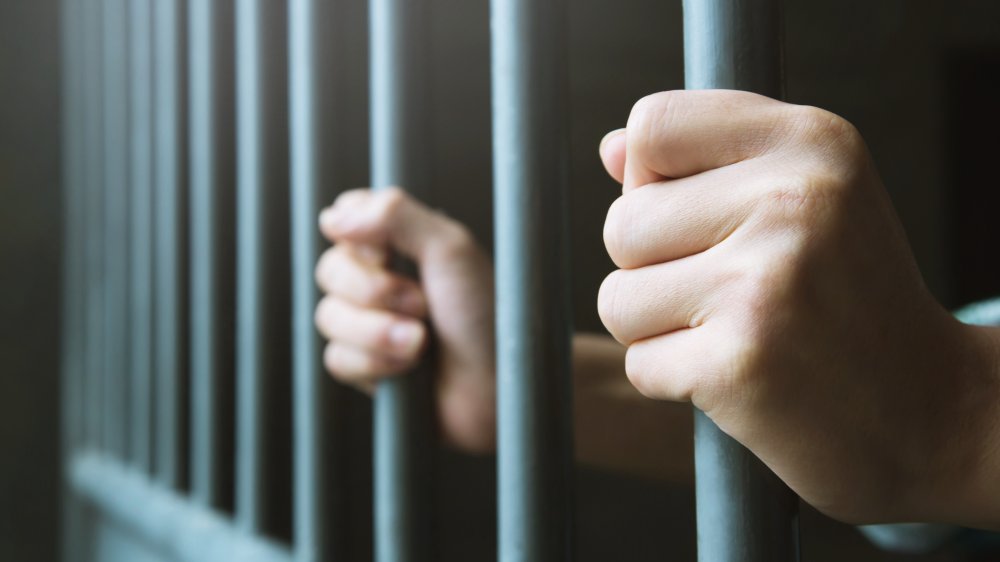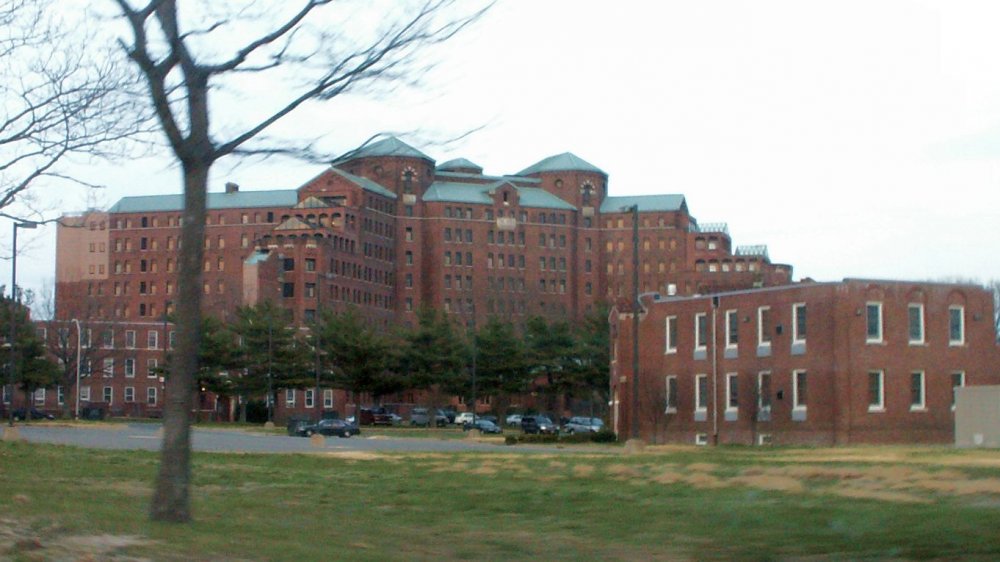What Really Went On Behind Closed Doors At The World's Largest Asylum
Psychiatric hospitals began popping up around the United States at the turn of the 19th century, promising a cure for mental illness. The institutions were built with the assumption that by offering them structure and rational surroundings, patients might eventually recover. Before these hospitals, people with mental illnesses were often put in local jails since there were no other alternatives.
A majority of the treatment during the 19th century was centered around "moral treatment," which focused on rehabilitation through normal activities such as farming or workshops. But as patient populations multiplied across hospitals across the country, practices shifted in the 20th century from treatment toward cures and prevention. During this time, eugenics was rising in popularity, and forced sterilization began manifesting as a "cure" at some psychiatric centers.
One of the largest psychiatric asylums in the United States was located in Brentwood, New York. Known as the Pilgrim State Psychiatric Center, it was the largest psychiatric hospital in the entire world at one time, according to Psychology Today. Still in operation today, the Pilgrim State Psychiatric Center evolved from the "moral treatments" of the 19th century into the "preventative cures" and electroshock therapies of the 20th century. Its history is as notorious as the history of psychiatric care itself. This is the story of what really went on behind closed doors at the world's largest asylum.
How the Pilgrim State Psychiatric Center came to be
By the turn of the 20th century, many mental health facilities in New York suffered from overcrowding. In response to this, in 1927, Governor Alfred Smith (pictured above) pushed the legislative body to set aside money that would allow for the allocation of a minimum of 10,000 beds toward a mental health center.
Named for Dr. Charles W. Pilgrim, who served as the commissioner of mental health in the early 20th century, the Pilgrim State Psychiatric Center in Brentwood, New York, was opened in 1931, according to the New York State Office of Mental Health. The grounds covered roughly 825 acres, and originally, 100 patients were transferred in from Central Islip State Hospital. Within nine months, 2,000 more patients were transferred. And in less than 25 years, the patient population had exploded to almost 15,000, making it, at the time, the largest hospital of its kind in the world. The center also had a staggering 4,000 employees by 1954.
The sheer size of the Pilgrim State Psychiatric Center was itself astounding. According to Classic New York History, it had its own police department, fire department, church, post office, and courts.
One of three
The Pilgrim State Psychiatric Center was one of three psychiatric hospitals on Long Island, along with Kings Park Psychiatric Center and Central Islip Psychiatric Center. The Pilgrim State Psychiatric Center was initially built to relieve the overcrowding in these two institutions, but unfortunately, it instead fell victim to the very symptom it was meant to alleviate.
Funnily enough, Kings Park Psychiatric Center (pictured above) was also built in 1885 to relieve overcrowding in other asylums at the time. But by 1954, the patient population at Kings Park had also exploded to almost 10,000. According to Opacity, at its peak, Kings Park Psychiatric Center had over 150 buildings, similar in size to Pilgrim State Psychiatric Center. But by the 1970s, more and more patients were transferred to nursing homes or Pilgrim State or were simply released.
According to Abandoned, Central Islip Psychiatric Center was a comparably massive institution, with more than 100 buildings and 2,500 employees at its own peak, making it the second-largest psychiatric hospital in the nation. But as with Kings Park, by the 1960s, the center started a process of deinstitutionalization, aiming to replace long-term psychiatric hospitalization with more open, community-based mental health services. By 1996, all the remaining patients from Central Islip and Kings Park had been transferred to Pilgrim State Psychiatric Center.
What were farm colonies?
Pilgrim State Psychiatric Center, Kings Park Psychiatric Center, and Central Islip Psychiatric Center were all originally built as farm colonies. Kings Park and Central Islip were the initial experiments, built in 1885 and 1887, respectively, and Pilgrim State Psychiatric Center was intended to follow their outline. According to The History and Influence of the American Psychiatric Association by Walter E. Barton, the farm colony system was first introduced in 1885 at the State Asylum in Kalamazoo, Michigan. After studying institutions in Europe, some American superintendents decided that patients with chronic yet stable conditions might benefit from outdoor activities and farm work.
All three of the centers had upwards of 1,000 acres of land in order to facilitate a farming environment. They also had multiple underground tunnels that connected the various buildings. And ultimately, farm colonies were meant to be self-sufficient and self-sustaining environments. As a result, according to the New York State Office of Mental Health, the Pilgrim State Psychiatric Center had its own sewage system, heating plant, electric light plant, and water works. And when Central Islip Psychiatric Center opened, its first patients were given the task of growing crops, sewing clothes, clearing the land, and making mattresses and furniture.
According to Classic New York History, the infrastructure of the Pilgrim State Psychiatric Center resembles what's currently found at New York State's many universities, which similarly run on independent grids.
Who was Henry Brill?
In 1932, Dr. Henry Brill was just a 25-year-old intern at the Pilgrim State Psychiatric Center. But by 1958, he had worked his way up to being director of the entire center. During his time at Pilgrim State, Brill saw that the methods used on patients, including lobotomies, electroshock therapy, and straitjackets, were more of a hindrance than a help to mental health. So when he became director in 1958, he advocated for the use of antipsychotics and tranquilizers, preferring these methods of treatment over insulin shock comas. In the latter part of his life, Brill was also head of New York's Drug Abuse Commission and frequently lectured on the dangers of marijuana.
But according to The Village Voice, Brill didn't always disavow the presiding treatment methods while he worked at Pilgrim State Psychiatric Center. During the 1940s and 1950s, around 2,000 people were lobotomized at Pilgrim State Psychiatric Hospital, and in 1949, Brill and two of his colleagues proudly recalled performing 350 prefrontal lobotomies in the last two years. He was also eager to endorse insulin shock therapy, which he learned of when he traveled to Europe during his time as an intern. However, Brill was ultimately essential to the process of deinstitutionalization during his tenure from 1958 to 1974, despite the damage he may have caused along the way.
Post-WWII boom
As Pilgrim State Psychiatric Center's population grew, the state of New York also constructed Edgewood State Hospital, later renamed the Mason General Hospital, which operated under Pilgrim State Psychiatric Center. According to The New York Times, during World War II, the Mason General Hospital was used for German prisoners and later as a tuberculosis hospital.
Also during the Second World War, the Mason General Hospital and three of the buildings at Pilgrim State Psychiatric Center (81, 82, and 83) were taken over by the War Department of the United States. They were utilized for soldiers who had battle fatigue, what we now call PTSD, from the war. According to HistoryNet, the documentary Let There Be Light, a film about the effects of PTSD on veterans, was filmed at the Mason facility and was responsible for shedding light on the pervasiveness of the condition. The Army wasn't pleased with the existence of the film, and in 1946, it pulled the documentary at the last minute before the premiere. John Huston (pictured above), its director, claimed that Army MPs had physically shown up and taken the film, classifying it as restricted.
It was after WWII that the Pilgrim State Psychiatric Center saw a surge in its patient population. During this period, the traditional techniques of rest and farming were substituted for more extreme methods, such as electroshock therapy and prefrontal lobotomies.
Lobotomies galore
The Pilgrim State Psychiatric Center is tragically notorious for its lobotomies. According to Opacity, prefrontal lobotomies started being performed at Pilgrim in 1946. By 1959, the number of lobotomies that had been performed was up to 2,000. Central medical building #23 especially was known as the place where the majority of the lobotomies were done.
While lobotomies were, unfortunately, commonly being performed across the United States, according to The Village Voice, roughly one out of every 25 occurred at Pilgrim State Psychiatric Center.
Tragically, by the 1990s, researchers had learned that not only did lobotomies not help patients recover from mental illness, but they often triggered even more problems. By 1991, even though the practice of prefrontal lobotomies had ceased, upwards of 200 people who had been subjected to lobotomies during their heyday were still at the Pilgrim State Psychiatric Center, rendered incapable of ever caring for themselves again. Based on cognitive tests, doctors found little difference between lobotomized patients and schizophrenics who hadn't been lobotomized. In some cases, it's even possible that some lobotomies led to schizophrenia rather than curing it.
Shock it out of you
Another popular method at the time for the treatment of schizophrenia and various other mental illnesses was electroshock therapy. Electroshock therapy involves passing a current of electricity through a patient's brain in order to induce a grand mal seizure. According to Freedom Magazine, by 1953, upwards of 300 patients at any given moment were being subjected to electroshock therapy at Pilgrim State Psychiatric Center.
Doctors advocated for the use of electroshock therapy into the 1970s, but its popularity died down by the end of the 20th century. However, there were still instances of Pilgrim State Psychiatric Center and other hospitals across the United States using electroshock therapy in the 21st century.
According to Long Island State Hospitals by Joseph M. Galente, electroshock therapy is considered an effective treatment for depression when medications don't work. Those who advocate for electroshock therapy have never been able to point to a definitive study or test to explain whether or not it works, but doctors continue to use it nonetheless. In fact, there are studies that suggest electroshock therapy simply induces brain damage. According to Opacity, Pilgrim State Psychiatric Center has even come under investigation for reportedly forcing electroshock therapy onto its patients.
Insulin shock therapy
Another method frequently used at Pilgrim State Psychiatric Center was insulin shock therapy, which entails injecting a patient with a large dose of insulin in order to induce seizure and a coma. According to Opacity, Pilgrim State started using this as a treatment in 1936. Patients as young as 19 were given insulin shock therapy, sometimes being placed into as many as 44 insulin comas. If that continued to be unsuccessful, the patient typically underwent a lobotomy. At Kings Park Psychiatric Center, there were two wards especially devoted to treating patients with schizophrenia using insulin shock therapy.
According to Shock Therapy: A History of Electroconvulsive Treatment in Mental Illness by Edward Shorter and David Healy, Europe had abandoned the use of insulin shock therapy as nurses and hospitals preoccupied themselves with battle wounds and warfare. But it was in Europe that insulin shock therapy was introduced to Americans, when four doctors separately visited Dr. Manfred Sakel in Vienna to learn about insulin shock therapy. One of them was a 27-year-old Henry Brill, eager to bring his learnings back to Pilgrim State Psychiatric Center.
What happened to Beulah Jones?
One of the most notorious cases to come out of Pilgrim State Psychiatric Center was that of Beulah Jones. According to NBC, Beulah Jones was admitted to Pilgrim State Psychiatric Center after she started to hear voices and began to claim that she was a lost queen of Scotland. In 1953, Jones was given 15 rounds of electroshock treatments over the course of ten weeks, but her delusions persisted. After five years of unsuccessful electroshock treatments, she was lobotomized, and as a result, she ended up spending the rest of her life institutionalized.
According to the Los Angeles Times, Jones' family was initially told that she would be away for six months. Then six months became ten years, and ten years became 20 years. In 1972, Pilgrim State Psychiatric Hospital notified Beulah's family that she was ready to be released, but her family realized that she was in need of long-term care that they couldn't facilitate themselves. Jones had a memory span of about 30 seconds.
In 2005, Jones' granddaughter Christine Johnson challenged Dr. Egas Moniz' reception of the 1949 Nobel Prize for the invention of lobotomies. She believes that if Moniz (pictured above) hadn't been given that award, thousands of peoples' lives could've been spared. While lobotomies are no longer practiced to the scale that they were, hundreds of people continue to suffer the consequences of this treatment.
The advent of pharmaceuticals
As pharmaceutical treatments improved, shock therapies and lobotomies fell by the wayside. Long-term psychiatric farm colonies began to shrink in size as well, especially as more and more people questioned the effectiveness of institutionalization. According to Nature, large-scale deinstitutionalization began in the late 1960s as many long-term inpatient psychiatric hospitals around the country were closed. Driven by a desire to cut costs as well as to facilitate more social integration, the movement relied on the optimistic belief in the therapeutic power of pharmaceuticals.
Inevitably, Pilgrim State Psychiatric Center also began decreasing its patient population. According to the New York State Office of Mental Health, Kings Park Psychiatric Center and Central Islip Psychiatric Center were both completely closed in 1996, with all of their patients transferred over to Pilgrim State. After more than a century, Pilgrim State Psychiatric Center was finally able to achieve its original purpose of relieving overcrowding.
From institutionalization to corrections
During the process of deinstitutionalization, there was the question of what to do with the massive campuses and buildings that had already been built and were now being left empty. One solution was to incorporate them into the now expanding prison-industrial complex.
In the 1980s, parts of Pilgrim State Psychiatric Center were used as a correctional facility. According to The New York Times, initially, the New York State Division for Youth had wanted to hold 80 juveniles who had been convicted of violent crimes in the psychiatric center's buildings. There was so much opposition from the community that the State Division for Youth decided against holding the juveniles there, but they still held the buildings as a potential place for relocation.
By 1982, Pilgrim State Psychiatric Center held 596 imprisoned people, moved to relieve overcrowding from jails in Nassau, Suffolk, and Queens. By 1983, they had remodeled the buildings to imprison up to 1,000 people. While former governor of New York Mario Cuomo kept promising to close the "prisons" as quickly as possible, it took until 1985 to remove all the imprisoned people from the prison at Pilgrim State Psychiatric Center.
Pilgrim today
While not all of the old buildings are still in use, Pilgrim State Psychiatric Center still operates as a state hospital and psychiatric facility. According to the New York State Office of Mental Health, Pilgrim offers a variety of inpatient, outpatient, and psychiatric services, though their capacity of 278 inpatient beds comes nowhere near the thousands they once held in their halls. The campus also now includes several residential agencies, such as Phoenix House, a treatment center for substance abuse, and Charles K. Post, a treatment center run by the New York State Office of Alcohol and Substance Abuse.
The campus also includes the Long Island Psychiatric Museum, which offers a look into the history of Kings Park, Central Islip, and Pilgrim State Psychiatric Center. However, while the museum includes equipment used for electroshock therapy, it's surprisingly silent on the topic of lobotomies. Alan Weinstock, then-director of Pilgrim State Psychiatric Hospital, admitted to the The New York Times in 2002 that "there's some negative connotation” to that particular form of treatment. He added that they were ”trying to keep this on a very positive spin.'"
